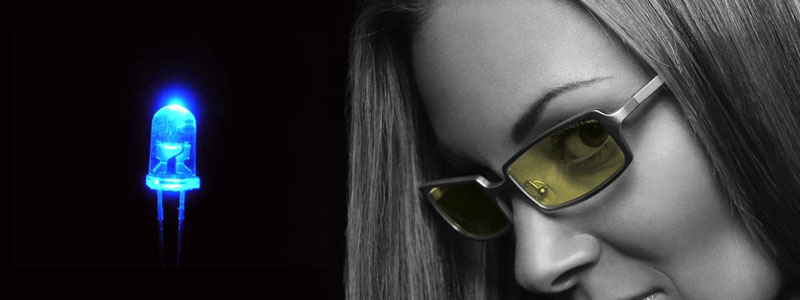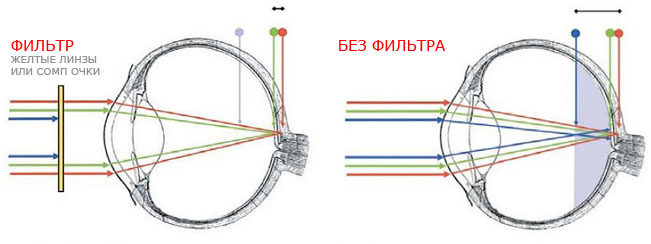RG | Blue Light Hazard

Continued Part 1 , Part 2
In the 80s of the twentieth century, when personal computers were just beginning to be widely used, the main problem was powerful radiation. The first monitors splashed a whole barrage of X-rays, electromagnetic fields of low and high frequencies. Against the background of a general panic, parents never ceased to restrict us in working behind a PC, citing the radiation that manufacturers have long been able to solve. Even it was proved that modern computers are not more dangerous than TV. Measurements have shown that a conventional electrical cable, near the desktop, produces more radiation than a monitor.
')
Everyone exhaled with the arrival of LCD / TFT monitors - no radiation, everyone is happy, and they could calmly explain to their parents that there is no need to worry anymore.
However, modern monitors, telephones, and other household and lighting devices are no less dangerous and no longer emit electromagnetic fields, but rays of the visible spectrum. For the eyes, the violet-blue region of the rays (shortwave) is the most harmful. Daily hours-long stay at the computer causes the development of eye diseases, eye fatigue, headaches, and sleep disturbance, and later mental disturbances, precisely because of the continuous exposure to violet and blue radiation quanta, since they are closer to the ultraviolet part of the spectrum.

Dream Nakamura
Currently, blue LEDs surround us everywhere. The first working blue LEDs were developed by the Japanese scientist Shuji Nakamura, who investigated alien (closed as dead-end) work in this direction.
Nakamura has built a new technology for the manufacture of LEDs, and not used advanced processes that have already been used for red and green LEDs.
Thus, the early stages of creating LEDs required a very expensive manufacturing process.
When Blue Diodes began to appear in products, they quickly gained popularity in industrial design. Every designer wanted to use a blue LED, because it was a completely new “fresh” color giving a high-tech look to the products. Later "Blue Light" fell in price, and the race for products for the attention of buyers has gone to a minimum, and the game went to a game of increased intensity of the blue light effect.
You ask, what's the difference? light is just light, and no matter what color it is.
In fact, blue light causes more eyestrain and fatigue than other colors. It is much harder for the human eye, makes it difficult to concentrate, throws more glare and blinding effects. It also affects the internal biological clock of a person, and later on sleep disturbance. Many researchers believe that even a very small level of blue light during sleep can weaken the immune system and have negative health effects.
Our eyes and brain have a lot of problems with blue light.
These problems are simply the side effects of evolution that adapted us to the natural environment of our planet.
Blue brighter in the dark
Besides the fact that the blue diode itself is 20 times brighter than red or green, it looks even brighter for us in the night, and creates the illusion of less bright ambient light around the source, the so-called Phenomenon (Shift) Purkinje which occurs due to increased the cone sensitivity in our eyes to a blue-green light.
A practical example of the Purkinje Phenomenon can be:
A cool blue power light on a TV can get your attention and let you buy this particular TV. But bringing it home and turning on your favorite channel at night, this same power light bulb will become annoyingly bright and disturbing for you to watch. Or the usual music column standing near the monitor.
Blue brighter in peripheral vision
The Purkinje shift is also noticeable in our peripheral vision, in low light conditions, since at the edge of the retina, cones are much larger than in the center.
Blue prevents clear vision
We tend to think that blue has a good, clear and clear picture. But paradoxically, our eyes cannot clearly focus on blue. We see a distracting halo around bright blue light sources.

This is because the violet-blue (short-wave) rays do not reach the retina in full - they simply scatter in the air. In the pupil, however, only the yellow and green (long-wavelength) rays are completely refracted. As a result of this irregularity, the image focusing on the retina partially loses its clarity.
The dilemma is that at the moment there are no ways to rid the eyes of such a load:
On the one hand, there are no means to completely remove the shortwave part of the spectrum from the path of the light flux from the monitor to the eyes, which would improve image clarity and reduce eye fatigue by reducing light scattering.
On the other hand, the elimination of violet and blue radiation will deprive the visible picture of full color, and this also increases eye strain.
We are half blind in the blue light.
The eyes of a modern person are arranged in such a way that small details are well distinguished in the first place with a green or red color. This is because we are weak with a clear distinction of detail in blue colors, or our eyes just don’t try to do it.
The most sensitive point on the retina is the central recess, which has no sticks to detect blue light. Yes, we are all color blind in the most sensitive part of our eyes.
In addition to all this, in the central part of the retina, the stain (macula) filters out the blue color in order to sharpen our vision.
Snipers and athletes often use tinted yellow lenses to get rid of the distracting blue light and have a clearer view of the environment.
Blue highlights interfere with vision
Double load on the eyes create glare and reflections from the source of blue light. Despite the fact that the retina does not process the blue, no one says that the remaining organs of the eye do not try to do it for it.
If we want to see small details on a blue background, then we strain our muscles and mow our eyes trying to highlight blue and focus on details. Try to do this for a very long amount of time, and you will probably earn yourself a headache. This will not happen on any other color background, since other colors of the spectrum provide better detail for the various elements.





Dazzling eye pain
Intense blue light can cause permanent photochemical damage to the retina. No one will argue that you are likely to suffer from this kind of injury due to hours of viewing a burning blue diode from a distance of a few millimeters. Nevertheless, there is an assumption that this may be an evolutionary driving force, a direct sense of pain from bright light with a very strong component of blue. The instinctive reaction of our body is to reduce the blue light entering the eyes, by closing the pupil. An example would be the inability to distinguish colors for some time after a camera flash.
Blue light and sleep disturbance
The light in the blue part of the spectrum suppresses melatonin levels in the body. Melatonin , sometimes called a sleep hormone, plays a key role in regulating the sleep and waking cycle. Thus, when the level of melatonin in the body is high, we sleep, when it is small, we wake up.
Blue light is a kind of natural alarm clock that wakes up everything alive as soon as the sky turns blue after sunrise. Even the light of one bright blue LED is enough to suppress melatonin levels.
Many people began to realize that they sleep badly precisely because of the burning indicators on the TV panel, and on other household appliances and gadgets. Also hit by burning monitors and fluorescent lights.
The reason why LEDs are viewed as a potential danger to sleep is that they have found their place in bedrooms, in essential ionizers, battery chargers, and other diverse packages. In some handicraft products, they are much brighter than they should be. Unlike traditional incandescent bulbs, fluorescent lamps are also sources of such harmful light.
Industrial Design
Several years ago, many companies were puzzled by this problem, and among the first companies that responded to this problem was Logitech , which promised to redesign its products in the shortest time possible.
Other less conscious companies in manufacturing countries like China do not even want to hear about the possible problems of users from their beloved blue LEDs. PC case manufacturers continue to hang cases with blue backlights, guided by great demand and do not bother writing warnings about possible problems, and do not offer other lighting colors.

In custody
Some tips:
According to the decree of the Ministry of Health and Medical Industry of the Russian Federation, people who have visual defects, when applying for work related to the use of computer equipment, are required to undergo a full ophthalmologic examination.
If you don’t wear glasses and you’ll have a good eye, do not hesitate to take care of your health and pick up computer glasses for yourself, others may laugh, but in the end you will be healthier.
UPD: Since the paranoia of the advertising of the post has passed, and due to the large number of questions on the subject of points, I am posting Q & A here:
Q: In the post "RG | Blue Light Hazard" you link to the store of recommended glasses, deleted on charges of advertising.
Can you share the link? I want to look at the prices and delivery options, maybe it will suit me.
A: I bought the Gunnar Computer Glasses glasses on www.thinkgeek.com , I also have an online store on the company's official website, but I am not familiar with the work, prices and delivery methods. You can probably buy glasses on eBay.
Q: By the way, as I understand it, you use them yourself. How long ago? How satisfied?
A: I use glasses for several months.
Ultimately, I avoided painful phenomena such as burning eyes, lacrimation, fatigue, blurring / blurring of the “picture” and various text after 6-8 hours of work.
For obvious reasons, it is not possible to engage in design with them, but to play and work with text is more than. The eyes do not get tired, the clarity of view increases when working behind the monitor, among other things, the glasses look stylish and they can be worn constantly, but after long wearing you should give your eyes a few minutes to rest before going out into the bright light without these or sunglasses.
Q: What the price depends on and whether there are cheaper analogues
A: The price of Gunmar, as I understand it, depends on the type of rim and the complexity of the geometry of the lenses, since it presents both the usual classic look and the stylish / sporty look. Cheaper analogues are on the Russian market, several users have suggested Fedorov glasses . You can also try to order the manufacture of glasses and lenses individually in the optics of the city.
Q: Are these glasses without diopters? Can I use them with lenses?
A: Yes, glasses without diopters, so unfortunately you can’t order glasses for yourself. You can certainly use them with lenses. This will probably be the best solution, but for convenience it’s still worth finding a solution that can meet the needs of a single product.
Video from SlashGear

In preparing the article used materials from the sites:
High-energy visible light
Arsenic Lighting & Danish Lighthouse, Founding Director Macular Degeneration Support
Evaluation of blue-light hazards from various light sources.
Source: https://habr.com/ru/post/94441/
All Articles